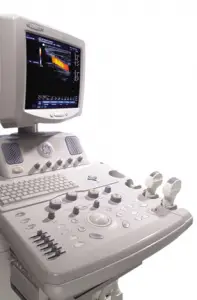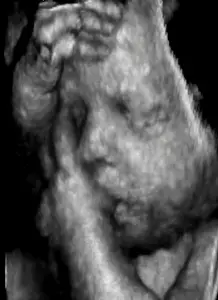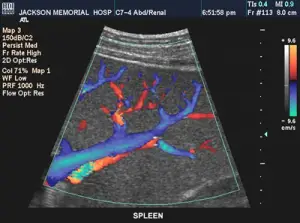What is Ultrasound?
Ultrasound or ultrasonography is a medical imaging technique that uses high-frequency sound waves and their echoes to create images of the inside of the body. This technique is similar to the SONAR used by submarines, echolocation used by bats, dolphins, and whales.

How Ultrasound Creates an Image
- A gel is applied to the body area which removes any air which would affect the signal. After this, a probe or transducer is placed on the skin.
- Ultrasound machine transmits high-frequency (1 to 10 MHz) sound pulses into the patient body with the help of a probe.
- The sound waves travel into the patient body and hit a boundary between tissues (for example, between a fluid and soft tissue, soft tissue, and bone).
- After that, some of the sound waves get reflected back to the probe and some travel on further until they reach another boundary and get reflected.
- These reflected waves are picked up by the probe and reach to the machine.
- The machine calculates the distance from the probe to the tissue or organ (boundaries) using the speed of sound in tissue (1,540 m/s) and the time of the each echo’s return.
- The ultrasound machine displays the distances and intensities of the echoes on the screen, forming a 2D image like the one shown below.
- A computer monitor displays the image which can be stored or printed
In an ultrasound, millions of pulses and echoes are sent and received each second. Another thing is that the probe can be moved along the surface of the body and angled to obtain various views.
Different Types of Ultrasound
The ultrasound that we have described so far presents a 2D image, or “slice,” of a 3D object (fetus, organ). Two other types of ultrasound are currently in use, Three Dimensional (3D) ultrasound imaging, and Doppler ultrasound.
(a) 3D Ultrasound Imaging
In 3D Ultrasound machines, several 2D images are acquired by moving the probes across the body surface or rotating inserted probes. The 2D scans are then combined by specialized computer software to form Three dimensional images.

3D imaging allows you to get a better look at the organ being examined and is best used for:
- visualizing blood flow in various organs or a fetus.
- examining the prostate gland for early detection of tumors
- Early detection of cancerous tumors
- visualizing a fetus to assess its development
(b) Doppler Ultrasound (or echocardiogram)
Doppler ultrasound is based upon the Doppler Effect.
- According to the doppler effect, When the object reflecting the ultrasound waves is moving, it changes the frequency of the echoes, creating a higher frequency if it is moving toward the probe and a lower frequency if it is moving away from the probe.
- How much the frequency is changed depends on how fast the object is moving.
- It measures the change in frequency of the echoes to calculate how fast an object is moving.
- It has been used mostly to measure the rate of blood flow through the heart and major arteries.

The advantage of ultrasound is that different structures can be observed without using radiation.
Uses of Ultrasound
- Urology: measuring blood flow through the kidney, seeing kidney stones, detecting prostate cancer early.
- Cardiology: measuring blood flow through the heart and major blood vessels, health of the heart.
- Obstetrics and Gynecology: measuring the size of the fetus, health of a fetus.
What are the Dangers of Ultrasound?
Ans. development of heat – tissues or water absorbs the ultrasound energy, formation of bubbles (cavitation) – when dissolved gases come out of solution due to local heat caused by ultrasound.
What are the different Ultrasound Treatments?
Ans. Ultrasound is best in many treatments like
- relieve pain and inflammation
- speed healing
- reduce muscle spasms
- increase range of motion
Ultrasound uses high-frequency sound waves. The sound waves vibrate tissues deep inside the injured area. This creates heat that draws more blood into the tissues. The tissues then respond to healing nutrients brought in by the blood and the repair process begins.
